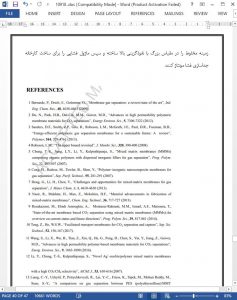Abstract
Recent advances on mixed matrix membrane for CO2 separation is reviewed in this paper. To improve CO2 separation performance of polymer membranes, mixed matrix membranes (MMMs) are developed. The concept of MMM is illustrated distinctly. Suitable polymer and inorganic or organic fillers for MMMs are summarized. Possible interface morphologies between polymer and filler, and the effect of interface morphologies on gas transport properties of MMMs are summarized. The methods to improve compatibility between polymer and filler are introduced. There are eight methods including silane coupling, Grignard reagents treatment, incorporation of additive, grafting, in situ polymerization, polydopamine coating, particle fusion approach and polymer functionalization. To achieve higher productivity for industrial application, mixed matrix composite membranes are developed. The recent development on hollow fiber and flat mixed matrix composite membrane is reviewed in detail. Last, the future trend of MMM is forecasted.
1 INTRODUCTION
The energy-efficient and environmentally friendly CO2 separation technology is increasingly necessary and has huge market in industrial application including CO2 capture, CO2 removal from flue gas, natural gas treatment and hydrogen purification[1-3]. Membrane-based gas separation is considered as the candidate technology. However, polymer membranes are shown to suffer a permeability-selectivity trade-off limitation[4]. Recently, mixed matrix membranes (MMMs) are developed to overcome the limitation [5-9]. In general, MMMs are fabricated by using two or more different materials of distinct properties. One material (usually a polymer) forms a continuous phase, also known as matrix. Another material forms a dispersed phase, inorganic or organic, which is the so-called filler. The matrix and filler is immiscible and possess different transport properties. There are a larger number of scientific literatures on MMMs for CO2 separation.
7 CONCLUSIONS
To improve CO2 separation performance of polymer membranes, a large number of MMMs have been developed. Generally, MMMs contain two or more different components. Polymer matrix forms a continuous phase, and inorganic or organic fillers act as a dispersed phase. To prepare high performance MMMs for CO2 separation, correct selection of polymer matrix and filler is essential. The polymer should possess high CO2 permeability and high CO2/gas selectivity. Moreover, the polymer should have high mechanical strength, and good thermal stability, chemical stability and processability. Matrimid® is the best polymer for CO2/CH4 separation under high pressure, and PVAm is the best polymer for CO2/N2, CO2/CH4 and CO2/H2 separation under low pressure. The filler should have high selectivity, good compatibility with polymer matrix, and small particle size. In the MMMs, the fillers not only disturb polymer chain packing and increase free volume, but also facilitate CO2 transport by itself. Compared with inorganic fillers, organic fillers are emerging fillers. PANI is the best filler for CO2/N2 separation, NHs is the best filler for CO2/CH4 separation, and MIL-53 is the best filler for CO2/H2 separation .











